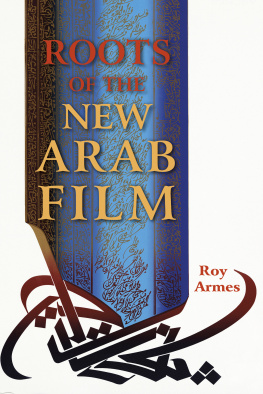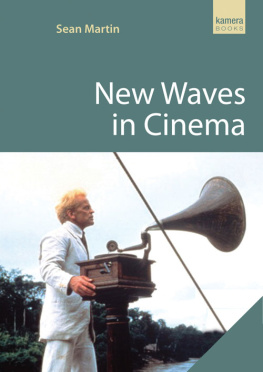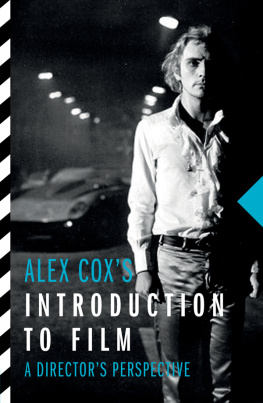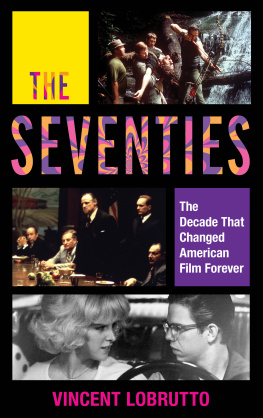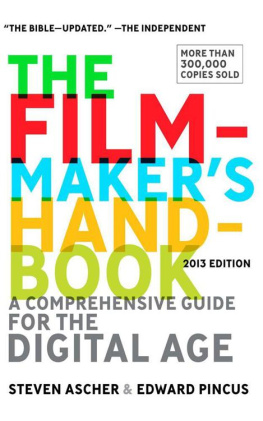
ROOTS OF THE NEW ARAB FILM
ROOTS OF THE NEW ARAB FILM
Roy Armes
Indiana University Press
This book is a publication of
Indiana University Press
Office of Scholarly Publishing
Herman B Wells Library 350
1320 East 10th Street
Bloomington, Indiana 47405 USA
iupress.indiana.edu
2018 by Roy Armes
All rights reserved
No part of this book may be reproduced or utilized in any form or by any means, electronic or mechanical, including photocopying and recording, or by any information storage and retrieval system, without permission in writing from the publisher. The Association of American University Presses Resolution on Permissions constitutes the only exception to this prohibition.
The paper used in this publication meets the minimum requirements of the American National Standard for Information SciencesPermanence of Paper for Printed Library Materials, ANSI Z39.48-1992.
Manufactured in the United States of America
Library of Congress Cataloging-in-Publication Data
Names: Armes, Roy, author.
Title: Roots of the new Arab film / Roy Armes.
Description: Bloomington, Indiana, USA : Indiana University Press, 2018. | Includes bibliographical references and index.
Identifiers: LCCN 2017046670| ISBN 9780253034182 (cloth : alk. paper) | ISBN 9780253031723 (pbk. : alk. paper)
Subjects: LCSH: Motion picture producers and directorsArab countries. | Motion picturesArab countries. | Motion pictures, ArabFrance.
Classification: LCC PN1993.5.A65 A77 2018 | DDC 791.430917/4927 dc23 LC record available at https://lccn.loc.gov/2017046670
1 2 3 4 523 22 21 20 19 18
To Annie
Genressuch as the novel, the short story, drama and framed paintingemerged in Arabic culture in the twentieth century as a result of a comprehensive process of change and cultural modernisation that occupied most of the nineteenth century. As soon as the process of modernity took root in the culture and started to yield its fruits, most of the Arab countries fell under the yoke of colonialism and the struggle for independence became inseparable from the quest for national identity. The literary and artistic elaboration of this identity was a vital element in the process of national transition.
Sabry Hafez
Contents
Acknowledgments
I GUESS I OWE a lot to my sister. Thanks to her, I saw my first film in 1943, when I was just six and she fourteen. Somehow she managed to sneak me into a backstreet cinema in Norwich for the rerun of Alexander Kordas imperial epic, The Four Feathers. The significance of the plot, Harry Faversham redeeming himself by doing the right thing, was beyond me, but the colors were wonderful and the Sudanese landscape was like nothing Id ever imagined. But when it came to the scene where a gallant British officer is blinded by vicious Arab fuzzy wuzzies (as they are called in the film) who hold a red-hot sword in front of his eyes, I apparently screamed inconsolably and had to be carried, kicking and struggling, out of the cinema. Life being what it is, I suppose it was inevitable that, from that moment on, I would be fascinated by film, spend my entire adult career working as a film historian, and find myself, at the age of eighty, publishing a three-volume study of contemporary Arab filmmaking. Proving, as always, the superiority of novelists over mere critics, Michael Ondaatje reveals that, as a child, he too saw the same film and also had to be dragged from the cinema. But in his case, it was only after the ending creditshe wanted more.
On a more serious note, many people have helped me with the compilation of this book, and I thank those, among them festival organizers and film distributors, who have guided me to new sources of material: Masoud Amralla Al Ali of the Gulf Film Festival, Catherine Arnaud, Marie-Claude Behna of the Association de Cinma Arabe, Stphanie Boring of Les Films dici, Mona Deeley of Zenith Films, Nick Denes of the Palestinian Film Foundation, Christian Eid of Abbout Productions, Alberto Elena of the Carlos III University in Madrid, Haithem El-Zabri of the Palestine Online Store, Yael Friedman, May Hossam of Misr International Films, Yara Jkel of Dschoint Ventschr, Tarik Khalami of the Centre Cinmatographique Marocain, Thierry Lenouvel of Cin-Sud Promotion, Nicole Mackey of Fortissimo Films, Diran Mardirian of Video Chico in Beirut, Egil Odegard of the Norwegian Film Institute, Lucy Parker, Anne-Ccile Pavaux of 3B Productions, Eliane Raheb of the Beirut Film Festival, Michel Riachi of Nadilekolnass in Beirut, John Sinno of Typecast Films in Seattle, Annabel Thomas, and Abdellah Zerguine of Regard Sud.
I am especially grateful to those filmmakers who helped provide access to DVD copies of their own films: Daoud Aoulad-Syad, Asma El Bakry, Jean-Claude Codsi, Najri Hajjaj, Nizar Hassan, Kassem Hawal, Abdelkader Lagta, Moez Kamoun, Mohamad Malas, Najwa Najjar, Yousry Nasrallah, Ghassan Salhab, Samir, Moumen Smihi, Heiny Srour, and Mohamed Zran.
I must thank most warmly Dee Mortensen, my editor at Indiana University Press, for commissioning this, the sixth successive book of the series on African and Arab cinemas, and all the staff at the press for the care with which they have produced this volume.
Last, but by no means least, I must thank the Leverhulme Trust for the further emeritus fellowship, which has helped fund the research for this volume and its predecessor.
Note
. Anthony Minghella, The English Patient (London: Methuen, 1997), vii.
Abbreviations
ACCT | Agence de Coopration Culturelle et Technique (France) |
AFAC | Arab Fund for Arts and Culture |
AIF | Agence Intergouvernementale de la Francophonie (France) |
ALBA | Acadmie Libanaise des Beaux Arts (Lebanon) |
ALN | Arme de Libration Nationale / National Liberation Army (Algeria) |
ANAF | Agence Nationale des Actualits Filmes (Algeria) |
CAAIC | Centre Algrien pour lArt et Industrie Cinmatographiques (Algeria) |
CAV | Centre Audio-Visuel (Algeria) |
CBA | Centre Bruxellois de lAudiovisuel (Belgium) |
CCM | Centre Cinmatographique Marocain (Morocco) |
CNC | Centre National Cinmatographique (France) |
CNCA | Centre National du Cinma Algrien (Algeria) |
CNSAD | Conservatoire National Suprieur dArt Dramatique |
DAMS | Dpartment dArt, de Musique et du Spectacle (part of the University of Bologna, Italy) |
ENADEC | Entreprise Nationale de Distribution et dExploitation Cinmatographiques (Algeria) |
ENAPROC | Entreprise Nationale de Production Cinmatographique (Algeria) |
ENPA | Entreprise Nationale de Productions Audiovisuelles (Algeria) |
ESAD | cole Suprieure dArt Dramatique (part of the University of Geneva, Switzerland) |
ESEC | cole Suprieure des tudes Cinmatographiques |
FAMU | Filmov Akademie Mzickych Umeni (Czechoslovakia) |
FAS | Fonds dAction Sociale (France) |
FED | Fonds Europen de Dveloppement (Brussels, Belgium) |
FEMIS |
Next page
